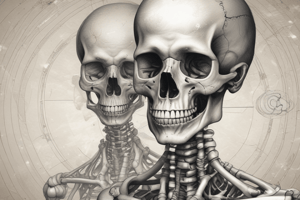Podcast
Questions and Answers
What is the second most common kidney anomaly?
What is the second most common kidney anomaly?
What does MCDK stand for in the context of kidney anomalies?
What does MCDK stand for in the context of kidney anomalies?
What is the distinguishing feature of MCDK on ultrasound examination?
What is the distinguishing feature of MCDK on ultrasound examination?
Which anomaly is characterized by an absence of one kidney?
Which anomaly is characterized by an absence of one kidney?
Signup and view all the answers
What is the most common anomaly of rotation in the context of genitourinary anomalies?
What is the most common anomaly of rotation in the context of genitourinary anomalies?
Signup and view all the answers
Which anomaly is characterized by the displacement of one kidney to the opposite side of the midline and fusion at the lower poles?
Which anomaly is characterized by the displacement of one kidney to the opposite side of the midline and fusion at the lower poles?
Signup and view all the answers
Which anomaly involves abnormal connection between the ureter and urinary bladder?
Which anomaly involves abnormal connection between the ureter and urinary bladder?
Signup and view all the answers
Which anomaly is characterized by an enlarged, distended bladder that can be palpated in the lower abdomen?
Which anomaly is characterized by an enlarged, distended bladder that can be palpated in the lower abdomen?
Signup and view all the answers
Which anomaly involves the abnormal positioning of the opening of the urethra on the underside of the penis?
Which anomaly involves the abnormal positioning of the opening of the urethra on the underside of the penis?
Signup and view all the answers
Which anomaly is characterized by failure of development of midline structures of the lower abdominal wall?
Which anomaly is characterized by failure of development of midline structures of the lower abdominal wall?
Signup and view all the answers
What is the main purpose of the DMSA nuclear study mentioned in the text?
What is the main purpose of the DMSA nuclear study mentioned in the text?
Signup and view all the answers
What is the management approach for supernumerary kidney without symptoms?
What is the management approach for supernumerary kidney without symptoms?
Signup and view all the answers
Which condition is characterized by the absence of renal tissue and lack of communication between them?
Which condition is characterized by the absence of renal tissue and lack of communication between them?
Signup and view all the answers
What is the consequence of unilateral renal agenesis in terms of blood flow?
What is the consequence of unilateral renal agenesis in terms of blood flow?
Signup and view all the answers
What is the most affected organ in cases of bilateral renal agenesis?
What is the most affected organ in cases of bilateral renal agenesis?
Signup and view all the answers
What is used as a diagnostic tool to confirm the presence of a supernumerary kidney?
What is used as a diagnostic tool to confirm the presence of a supernumerary kidney?
Signup and view all the answers



